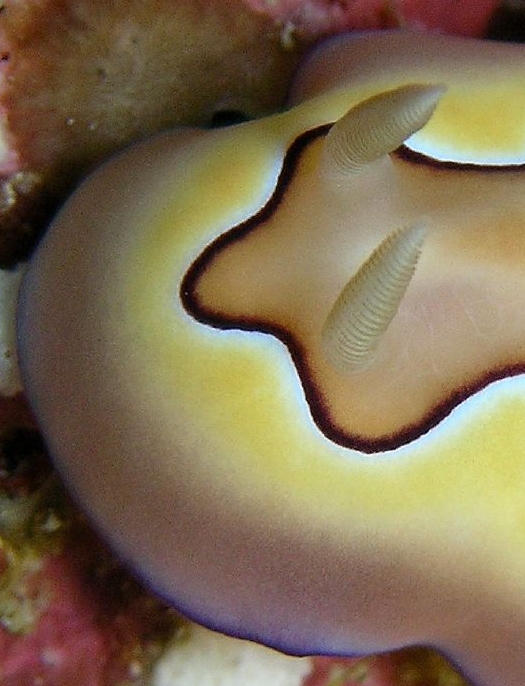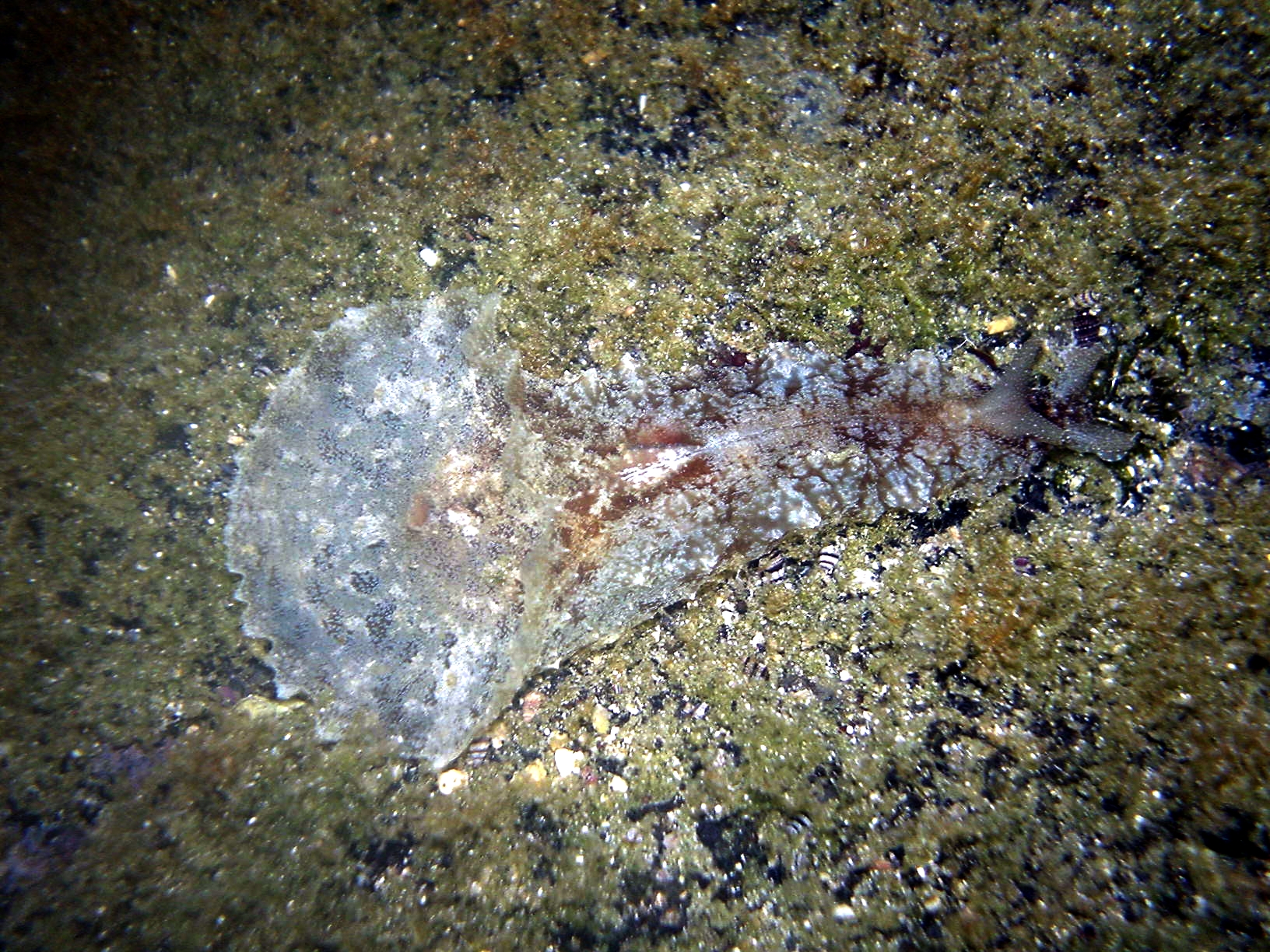|
Rhinophores
A rhinophore is one of a pair of chemosensory club-shaped, rod-shaped or ear-like structures which are the most prominent part of the external head anatomy in sea slugs, marine gastropod opisthobranch mollusks such as the nudibranchs, sea hares (Aplysiomorpha), and sap-sucking sea slugs (Sacoglossa). Etymology The name relates to the rhinophore's function as an organ of "smell". ''Rhino-'' means nose from Ancient Greek ῥίς ''rhis'' and from its genitive ῥινός ''rhinos''. "Phore" means "to bear" from Neo-Latin ''-phorus'' and from Greek -phoros (φορος) "bearing", a derivative of ''phérein'' (φέρειν). Function Rhinophores are scent or taste receptors, also known as chemosensory organs situated on the dorsal surface of the head. They are primarily used for distance chemoreception and rheoreception (response to water current). The "scents" detected by rhinophores are chemicals dissolved in the sea water. The fine structure and hairs of the rhinophor ... [...More Info...] [...Related Items...] OR: [Wikipedia] [Google] [Baidu] |
Aplysiomorpha
The order Aplysiida, commonly known as sea hares (''Aplysia'' species and related genera), are medium-sized to very large opisthobranch gastropod molluscs with a soft internal shell made of protein. These are marine gastropod molluscs in the superfamilies Aplysioidea and Akeroidea. The common name "sea hare" is a direct translation from , as the animal's existence was known in Roman times. The name derives from their rounded shape and from the two long rhinophores that project upward from their heads and that somewhat resemble the ears of a hare. Taxonomy Many older textbooks and websites refer to this suborder as "Aplysiida". The original author Paul Henri Fischer described the taxon Aplysiida at unspecified rank above family. In 1925 Johannes Thiele established the taxon Aplysiida as a suborder. 2005 taxonomy Since the taxon Aplysiida was not based on an existing genus, this name is no longer available according to the rules of the ICZN. Aplysiida has been replace ... [...More Info...] [...Related Items...] OR: [Wikipedia] [Google] [Baidu] |
Sea Slugs
Sea slug is a common name for some marine invertebrates with varying levels of resemblance to terrestrial slugs. Most creatures known as sea slugs are gastropods, i.e. they are sea snails (marine gastropod mollusks) that, over evolutionary time, have either entirely lost their shells or have seemingly lost their shells due to having a significantly reduced or internal shell. The name "sea slug" is often applied to nudibranchs and a paraphyletic set of other marine gastropods without apparent shells. Sea slugs have an enormous variation in body shape, color, and size. Most are partially translucent. The often bright colors of reef-dwelling species imply that these animals are under constant threat of predators. Still, the color can warn other animals of the sea slug's toxic stinging cells ( nematocysts) or offensive taste. Like all gastropods, they have small, razor-sharp teeth called radulas. Most sea slugs have a pair of rhinophores—sensory tentacles used primarily for ... [...More Info...] [...Related Items...] OR: [Wikipedia] [Google] [Baidu] |
Chromodoris Coi Rhinophores
''Chromodoris'' is a genus of very colourful sea slugs or dorid nudibranchs, marine gastropod molluscs, and the type genus of the family Chromodorididae. Within the genus ''Chromodoris'', there are currently 101 classified species. Species within ''Chromodoris'' are commonly found in tropical and subtropical waters, living as members of reef communities and preying primarily on sponges. A molecular phylogeny of the family Chromodorididae resulted in this genus being restricted to a smaller number of species than formerly, most of which have longitudinal black lines on the mantle. Many former members of ''Chromodoris'' were transferred to Goniobranchus Anatomy ''Chromodoris'' species exhibit one of the two major body types found within Nudibranchia. There are a few major bodily features that separate chromodorids from other sea slugs. Mantle Dorids have a thick mantle that exists over their foot, and in some species, the mantle can have tubercles (nodules along the surface of an ... [...More Info...] [...Related Items...] OR: [Wikipedia] [Google] [Baidu] |
Sea Sponges
Sponges or sea sponges are primarily marine invertebrates of the animal phylum Porifera (; meaning 'pore bearer'), a basal clade and a sister taxon of the diploblasts. They are sessile filter feeders that are bound to the seabed, and are one of the most ancient members of macrobenthos, with many historical species being important reef-building organisms. Sponges are multicellular organisms consisting of jelly-like mesohyl sandwiched between two thin layers of cells, and usually have tube-like bodies full of pores and channels that allow water to circulate through them. They have unspecialized cells that can transform into other types and that often migrate between the main cell layers and the mesohyl in the process. They do not have complex nervous, digestive or circulatory systems. Instead, most rely on maintaining a constant water flow through their bodies to obtain food and oxygen and to remove wastes, usually via flagella movements of the so-called "collar cells". S ... [...More Info...] [...Related Items...] OR: [Wikipedia] [Google] [Baidu] |
Aplysia Californica Rhinophore 4
''Aplysia'' () is a genus of medium-sized to extremely large sea slugs, specifically sea hares, which are a kind of marine gastropod mollusk. These benthic herbivorous creatures can become rather large compared with most other mollusks. They graze in tidal and subtidal zones of tropical waters, mostly in the Indo-Pacific Ocean (23 species); but they can also be found in the Atlantic Ocean (12 species), with a few species occurring in the Mediterranean. ''Aplysia'' species, when threatened, frequently release clouds of ink, it is believed in order to blind the attacker (though they are in fact considered edible by relatively few species). Following the lead of Eric R. Kandel, the genus has been studied as a model organism by neurobiologists, because its gill and siphon withdrawal reflex, as studied in ''Aplysia californica'', is mediated by electrical synapses, which allow several neurons to fire synchronously. This quick neural response is necessary for a speedy reaction ... [...More Info...] [...Related Items...] OR: [Wikipedia] [Google] [Baidu] |
Dendrite
A dendrite (from Ancient Greek language, Greek δένδρον ''déndron'', "tree") or dendron is a branched cytoplasmic process that extends from a nerve cell that propagates the neurotransmission, electrochemical stimulation received from other neural cells to the cell body, or soma (biology), soma, of the neuron from which the dendrites project. Electrical stimulation is transmitted onto dendrites by upstream neurons (usually via their axons) via synapses which are located at various points throughout the dendritic tree. Dendrites play a critical role in integrating these synaptic inputs and in determining the extent to which action potentials are produced by the neuron. Structure and function Dendrites are one of two types of cytoplasmic processes that extrude from the cell body of a neuron, the other type being an axon. Axons can be distinguished from dendrites by several features including shape, length, and function. Dendrites often taper off in shape and are shorter, ... [...More Info...] [...Related Items...] OR: [Wikipedia] [Google] [Baidu] |
Ganglia
A ganglion (: ganglia) is a group of neuron cell bodies in the peripheral nervous system. In the somatic nervous system, this includes dorsal root ganglia and trigeminal ganglia among a few others. In the autonomic nervous system, there are both sympathetic and parasympathetic ganglia which contain the cell bodies of postganglionic sympathetic and parasympathetic neurons respectively. A pseudoganglion looks like a ganglion, but only has nerve fibers and has no nerve cell bodies. Structure Ganglia are primarily made up of somata and dendritic structures, which are bundled or connected. Ganglia often interconnect with other ganglia to form a complex system of ganglia known as a plexus. Ganglia provide relay points and intermediary connections between different neurological structures in the body, such as the peripheral and central nervous systems. Among vertebrates there are three major groups of ganglia: * Dorsal root ganglia (also known as the spinal ganglia) cont ... [...More Info...] [...Related Items...] OR: [Wikipedia] [Google] [Baidu] |
Axon
An axon (from Greek ἄξων ''áxōn'', axis) or nerve fiber (or nerve fibre: see American and British English spelling differences#-re, -er, spelling differences) is a long, slender cellular extensions, projection of a nerve cell, or neuron, in Vertebrate, vertebrates, that typically conducts electrical impulses known as action potentials away from the Soma (biology), nerve cell body. The function of the axon is to transmit information to different neurons, muscles, and glands. In certain sensory neurons (pseudounipolar neurons), such as those for touch and warmth, the axons are called afferent nerve fibers and the electrical impulse travels along these from the peripheral nervous system, periphery to the cell body and from the cell body to the spinal cord along another branch of the same axon. Axon dysfunction can be the cause of many inherited and acquired neurological disorders that affect both the Peripheral nervous system, peripheral and Central nervous system, central ne ... [...More Info...] [...Related Items...] OR: [Wikipedia] [Google] [Baidu] |
Sensory Neuron
Sensory neurons, also known as afferent neurons, are neurons in the nervous system, that convert a specific type of stimulus, via their receptors, into action potentials or graded receptor potentials. This process is called sensory transduction. The cell bodies of the sensory neurons are located in the dorsal root ganglia of the spinal cord. The sensory information travels on the afferent nerve fibers in a sensory nerve, to the brain via the spinal cord. Spinal nerves transmit external sensations via sensory nerves to the brain through the spinal cord. The stimulus can come from exteroreceptors outside the body, for example those that detect light and sound, or from interoreceptors inside the body, for example those that are responsive to blood pressure or the sense of body position. Types and function Sensory neurons in vertebrates are predominantly pseudounipolar or bipolar, and different types of sensory neurons have different sensory receptors that respond t ... [...More Info...] [...Related Items...] OR: [Wikipedia] [Google] [Baidu] |
Epithelium
Epithelium or epithelial tissue is a thin, continuous, protective layer of cells with little extracellular matrix. An example is the epidermis, the outermost layer of the skin. Epithelial ( mesothelial) tissues line the outer surfaces of many internal organs, the corresponding inner surfaces of body cavities, and the inner surfaces of blood vessels. Epithelial tissue is one of the four basic types of animal tissue, along with connective tissue, muscle tissue and nervous tissue. These tissues also lack blood or lymph supply. The tissue is supplied by nerves. There are three principal shapes of epithelial cell: squamous (scaly), columnar, and cuboidal. These can be arranged in a singular layer of cells as simple epithelium, either simple squamous, simple columnar, or simple cuboidal, or in layers of two or more cells deep as stratified (layered), or ''compound'', either squamous, columnar or cuboidal. In some tissues, a layer of columnar cells may appear to be stratified d ... [...More Info...] [...Related Items...] OR: [Wikipedia] [Google] [Baidu] |







